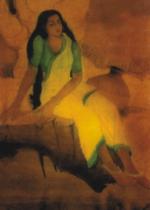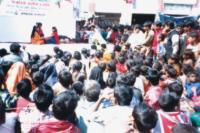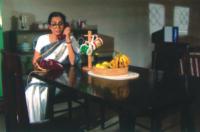Lalon Lost in Singing
 What
is Lalon without his songs? That doesn't mean that a movie on
Lalon, a poet, mystic and the guiding spirit of the bauls
of bygone Bengal, should solely bank on his songs. Granted,
that the man is still shrouded in the mystery of his own cult,
and history has not given us too many clues to his private life,
yet that is no excuse for a movie to go berserk and take on
a form of a song-heavy mishmash.
What
is Lalon without his songs? That doesn't mean that a movie on
Lalon, a poet, mystic and the guiding spirit of the bauls
of bygone Bengal, should solely bank on his songs. Granted,
that the man is still shrouded in the mystery of his own cult,
and history has not given us too many clues to his private life,
yet that is no excuse for a movie to go berserk and take on
a form of a song-heavy mishmash.
This productive
public figure of the nineteenth century Nodia, known as Kustia
today, is mostly popular for his songs. However, the fact that
Lalon is not the sum total of his songs or thoughts is something
that one must take into account, if his life is to be depicted
in any form. The movie Lalon tries the opposite.
The
man had a life that he lived among his contemporaries, mentors,
disciples and most importantly his relations and partner in
life and meditation. He had interacted with all these people,
plowed his paddy field, gone out to spread his ideas succinctly
defined by atto-totto (self-knowledge) while mounted
on a horse. In all probability, he must have been a man of action
who thrived on philosophical discourse. Self-absorbed romanticist,
he never was. His writings stand proof of that.
The movie
Lalon, written and directed by Tanvir Mokammel, tells a different
tale. Or it might be fitting to say that it stands clear off
of any such trouble. Telling a tale in the language of cinema
is hard, Mokammel's effort is proof of that. He, as a screenplay
writer, also proves that it is a Herculean task to chart the
life of a man about whose life we have little knowledge. The
movie projects Lalon as a wandering minstrel, a kind that cultivates
an eye for natural splendour. In many a setting, Lalon (Azad
Abul Kalam cast as the young Lalon and Raisul Islam Asad as
older Lalon) walks about the wilderness and sings to his hearts
content without taking into account the life of Lalon and the
reaction of the viewers. By celebrating the songs, the movie
leaves out Lalon's life, and lets it course through a pseudo-storyline
that may at best be called a timid interpretation of whatever
evidence of Lalon's life the director could put his hands on.
This
farce -- the movie -- strings one song after another, most in
romantic settings. The lore of the baul, in turn, is
transformed into one continuous refresher course. It is a classic
example of the ignorant iconophile doing disservice to the integrity
of the icon, unknowingly, of course.
Oriental
Sight
 Oriental
art has a look of its own. It gives off a kind of delicate visual
beauty that builds on smooth wash of colours and subtle lines.
This may be considered a limitation by many, but the same too
has been a staple for a lot of exponents of visual art. Shahneoyaj
Cacoly too is fully into this watercolour-based mode of art.
Her works are certainly in conformity with this distinct oriental
characteristic. Human figures are her forte. That does not mean
that she stays clear of foraying into abstract composition.
Oriental
art has a look of its own. It gives off a kind of delicate visual
beauty that builds on smooth wash of colours and subtle lines.
This may be considered a limitation by many, but the same too
has been a staple for a lot of exponents of visual art. Shahneoyaj
Cacoly too is fully into this watercolour-based mode of art.
Her works are certainly in conformity with this distinct oriental
characteristic. Human figures are her forte. That does not mean
that she stays clear of foraying into abstract composition.
Her solo
at the newly established Gallery Dhrupad was a homage to the
academic oriental style of rendering figures, mostly female.
In today's world, interest in anything Oriental is back in vogue,
but the kind of oriental art that is practised in the institutions
are heavily inclined to a visual solution where stylisation
of figures only make way for tepid expressions. Many artists
are veering towards something different to escape this very
formal kind of art making. However, Cacoly still is satisfied
with this mode, and applies her craft with precision. It is
this precision that gives her work a distinct flavour.
In works
like the Past, her eye for detail mingles with the abundance
of black cloud-like wash that reminds one of black and white
treatment of scenery by the Chinese. As for the rendition of
the damsels, which are the staples in academic oriental version
in Bangladesh, Cacoly's painting is a tribute to the colour
yellow. Perhaps, in her case, colour is one thing, if explored
to its full scope, might accrue good results in future.
Voice of the Underprivileged
 APARAJEYO
Bangla once again organised a cultural programme that included
a drama staged by underprivileged children. The function kicked
off with songs and recitation of poetry by two little girls,
Moushumi and Shyamoli. A drama following the song and recitation
session was a social realist presentation. The drama "Sleeping
Humans" was written and directed by Mahbubur Rahman, who
teaches music to these kids at their home for underprivileged
children in East Tejtury Bazar near Karwan Bazar. As for the
kids, they had the day of their lives on the stage set up in
the open square of the Karwan Bazar Market-2 on January 28 ,
2004.
APARAJEYO
Bangla once again organised a cultural programme that included
a drama staged by underprivileged children. The function kicked
off with songs and recitation of poetry by two little girls,
Moushumi and Shyamoli. A drama following the song and recitation
session was a social realist presentation. The drama "Sleeping
Humans" was written and directed by Mahbubur Rahman, who
teaches music to these kids at their home for underprivileged
children in East Tejtury Bazar near Karwan Bazar. As for the
kids, they had the day of their lives on the stage set up in
the open square of the Karwan Bazar Market-2 on January 28 ,
2004.
Although
the drama was interrupted by mechanical glitch, one of the elder
children, Farooq chipped in with his two consecutive songs that
he himself wrote and composed. He enthralled the crowd at the
Bazar so much so that even when the overhead microphones that
were acting up were fixed, the crowd asked the boy to continue.
But the drama too, after the sound system was revived, seemed
to have won over the crowd. Its scenario was simple and designed
to inform the viewers about the danger of children being monopolised
into serving to appease the adult vices. It strove to encompass
everything from enforced drug retailing and other inescapable
predicaments that the underprivileged kids find themselves into,
to the abuses that are being meted out to them.
Aparajeyo-Bangladesh
has been working with these children since 2002, and has been
campaigning for better treatment to children while trying to
rehabilitate the ones who are often called street children.
Nandan
Kanan: Urbanisation and its Parasites in Focus
 The
story of the drama “Nandan Kanan” centres on an elderly woman,
who lives alone in an affluent part of Dhaka. Apart from the
sudden emergence of a relation, her niece, the old lady's only
strong connection with other people is through the telephone
calls she receives from the only son living abroad. The urban
condition of living in isolation -- in total obscurity -- is
only disrupted when a man comes to pester her to give up her
land to a certain developer. The events that follow see a group
of young men, who were suddenly discovered when she enters her
home coming back from the bazar with her groceries, taking over
her house and continuing to live there. They, the thugs, forcefully
become houseguests. Some of them even take part in cooking and
in running errands. Although their motive was sinister, it was
to force the old lady in signing the contract, the author of
the drama brings in a lot of wit and develops emotional tangles
to tone the otherwise hostile situation with intermediary colours.
The
story of the drama “Nandan Kanan” centres on an elderly woman,
who lives alone in an affluent part of Dhaka. Apart from the
sudden emergence of a relation, her niece, the old lady's only
strong connection with other people is through the telephone
calls she receives from the only son living abroad. The urban
condition of living in isolation -- in total obscurity -- is
only disrupted when a man comes to pester her to give up her
land to a certain developer. The events that follow see a group
of young men, who were suddenly discovered when she enters her
home coming back from the bazar with her groceries, taking over
her house and continuing to live there. They, the thugs, forcefully
become houseguests. Some of them even take part in cooking and
in running errands. Although their motive was sinister, it was
to force the old lady in signing the contract, the author of
the drama brings in a lot of wit and develops emotional tangles
to tone the otherwise hostile situation with intermediary colours.
The drama
loses its footing only when the obstinate lady almost becoming
psychotic. She first tries to poison them by mixing rat-poison
in their tea, which fails as the rat poison was already being
replaced by sugar, and later she almost attempts to stab one
of the five gang members. These scenes, especially the latter
one, fail to address the emotional turmoil the lady (played
by Dilara Zaman) finds herself in. All in all, her relationship
with these ill-intentioned men seems bereft of any real sign
of foreboding. This is where the director could really have
made a difference. Although the last minute skirmishing among
themselves left their leader dead, that dramatic development
too, it seems, needed a high pitched delivery in the tone of
hostility.
Still, as
a witty and visually interesting drama, “Nandan Kanan” deserves
kudos. It was the 11th production of Dibyo Dristi. The drama
was directed by Akram Khan and premiered on 23 January 2004
at the auditorium of the Russian Cultural Centre.

 What
is Lalon without his songs? That doesn't mean that a movie on
Lalon, a poet, mystic and the guiding spirit of the bauls
of bygone Bengal, should solely bank on his songs. Granted,
that the man is still shrouded in the mystery of his own cult,
and history has not given us too many clues to his private life,
yet that is no excuse for a movie to go berserk and take on
a form of a song-heavy mishmash.
What
is Lalon without his songs? That doesn't mean that a movie on
Lalon, a poet, mystic and the guiding spirit of the bauls
of bygone Bengal, should solely bank on his songs. Granted,
that the man is still shrouded in the mystery of his own cult,
and history has not given us too many clues to his private life,
yet that is no excuse for a movie to go berserk and take on
a form of a song-heavy mishmash.  Oriental
art has a look of its own. It gives off a kind of delicate visual
beauty that builds on smooth wash of colours and subtle lines.
This may be considered a limitation by many, but the same too
has been a staple for a lot of exponents of visual art. Shahneoyaj
Cacoly too is fully into this watercolour-based mode of art.
Her works are certainly in conformity with this distinct oriental
characteristic. Human figures are her forte. That does not mean
that she stays clear of foraying into abstract composition.
Oriental
art has a look of its own. It gives off a kind of delicate visual
beauty that builds on smooth wash of colours and subtle lines.
This may be considered a limitation by many, but the same too
has been a staple for a lot of exponents of visual art. Shahneoyaj
Cacoly too is fully into this watercolour-based mode of art.
Her works are certainly in conformity with this distinct oriental
characteristic. Human figures are her forte. That does not mean
that she stays clear of foraying into abstract composition.
 APARAJEYO
Bangla once again organised a cultural programme that included
a drama staged by underprivileged children. The function kicked
off with songs and recitation of poetry by two little girls,
Moushumi and Shyamoli. A drama following the song and recitation
session was a social realist presentation. The drama "Sleeping
Humans" was written and directed by Mahbubur Rahman, who
teaches music to these kids at their home for underprivileged
children in East Tejtury Bazar near Karwan Bazar. As for the
kids, they had the day of their lives on the stage set up in
the open square of the Karwan Bazar Market-2 on January 28 ,
2004.
APARAJEYO
Bangla once again organised a cultural programme that included
a drama staged by underprivileged children. The function kicked
off with songs and recitation of poetry by two little girls,
Moushumi and Shyamoli. A drama following the song and recitation
session was a social realist presentation. The drama "Sleeping
Humans" was written and directed by Mahbubur Rahman, who
teaches music to these kids at their home for underprivileged
children in East Tejtury Bazar near Karwan Bazar. As for the
kids, they had the day of their lives on the stage set up in
the open square of the Karwan Bazar Market-2 on January 28 ,
2004.  The
story of the drama “Nandan Kanan” centres on an elderly woman,
who lives alone in an affluent part of Dhaka. Apart from the
sudden emergence of a relation, her niece, the old lady's only
strong connection with other people is through the telephone
calls she receives from the only son living abroad. The urban
condition of living in isolation -- in total obscurity -- is
only disrupted when a man comes to pester her to give up her
land to a certain developer. The events that follow see a group
of young men, who were suddenly discovered when she enters her
home coming back from the bazar with her groceries, taking over
her house and continuing to live there. They, the thugs, forcefully
become houseguests. Some of them even take part in cooking and
in running errands. Although their motive was sinister, it was
to force the old lady in signing the contract, the author of
the drama brings in a lot of wit and develops emotional tangles
to tone the otherwise hostile situation with intermediary colours.
The
story of the drama “Nandan Kanan” centres on an elderly woman,
who lives alone in an affluent part of Dhaka. Apart from the
sudden emergence of a relation, her niece, the old lady's only
strong connection with other people is through the telephone
calls she receives from the only son living abroad. The urban
condition of living in isolation -- in total obscurity -- is
only disrupted when a man comes to pester her to give up her
land to a certain developer. The events that follow see a group
of young men, who were suddenly discovered when she enters her
home coming back from the bazar with her groceries, taking over
her house and continuing to live there. They, the thugs, forcefully
become houseguests. Some of them even take part in cooking and
in running errands. Although their motive was sinister, it was
to force the old lady in signing the contract, the author of
the drama brings in a lot of wit and develops emotional tangles
to tone the otherwise hostile situation with intermediary colours.